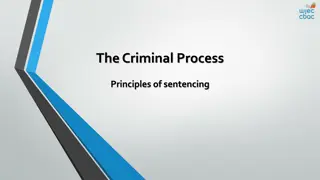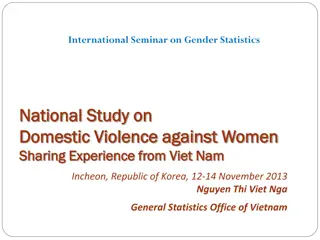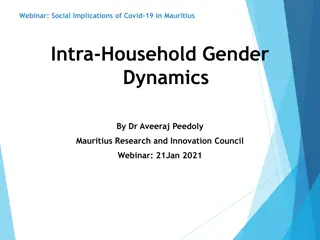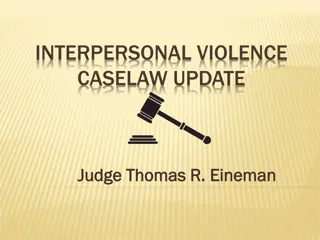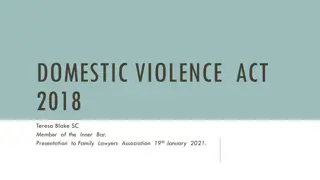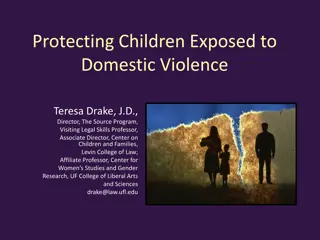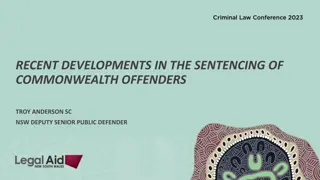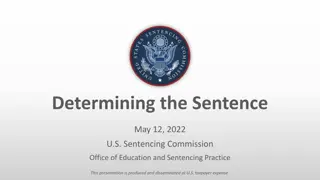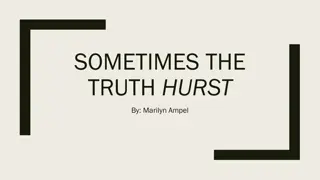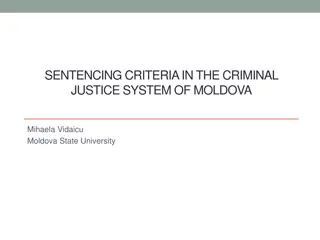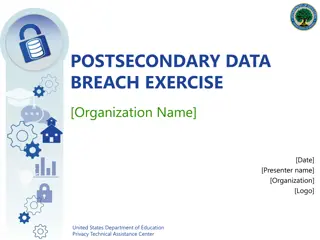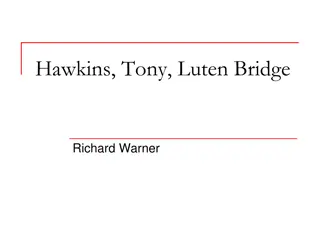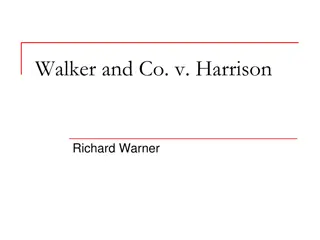Patterns in Domestic Violence Order Breach Sentencing Outcomes
Explore the patterns in sentencing outcomes for breaches of domestic violence orders over time, legislative and community contexts, key findings, and current study results in the field of criminology at Griffith University.
Download Presentation

Please find below an Image/Link to download the presentation.
The content on the website is provided AS IS for your information and personal use only. It may not be sold, licensed, or shared on other websites without obtaining consent from the author. Download presentation by click this link. If you encounter any issues during the download, it is possible that the publisher has removed the file from their server.
E N D
Presentation Transcript
Exploring the Sentencing Breaches of Domestic Violence Orders Christine Bond Griffith University c.bond@griffitth.edu.au
What are the patterns in sentence outcomes for domestic violence order breaches over time? Griffith Criminology Institute
Legislative Context Stand alone legislation for protection orders in 1989 With amendments in 1992, 1999, 2002 around scope, recognition of interstate orders, length of order Large scale more contemporary reforms in 2012 legislation Griffith Criminology Institute
Community Context Early 1990s investments in community services in certain locations By end of 1990s to early 2000s court support by end of 1990s to early 2000s Urban high volume running separate applications lists But breaches remain in general criminal lists Griffith Criminology Institute
What do we know? Differing profiles for those with custodial vs non-custodial Fines = preferred penalty Increasing use of imprisonment, but fines remain popular Griffith Criminology Institute
Current Study Adult court lower court administrative data 1994-2012; 2000-2012 Case-based Population of breach convictions: 49,321 12.1% female offenders; 29.3% Indigenous Median age 33.5 yrs Most common sentence outcome = fine (55.6%) Griffith Criminology Institute
Current Study Sentencing outcome custodial , probation, other community-based, fine, other Key variables Sex of defendant Defendant demographic characteristics Legal and case characteristics Griffith Criminology Institute
100 90 Trends in sentence outcomes for DVO breaches 80 70 60 Per cent 50 40 30 20 10 0 2006 1994 1995 1996 1997 1998 1999 2000 2001 2002 2003 2004 2005 2007 2008 2009 2010 2011 2012 Custodial Probation Other community Fine Other N=49,321 (lower court)
100 90 Trends in sentence outcomes for DVO breaches 80 70 Per cent 60 50 40 30 20 10 0 2006 1994 1995 1996 1997 1998 1999 2000 2001 2002 2003 2004 2005 2007 2008 2009 2010 2011 2012 Custodial Probation Fine Linear (Custodial) Linear (Probation) Linear (Fine) N=49,321 (lower court)
100 90 Trends in sentence outcomes for DVO breaches 80 70 60 Per cent 50 40 30 20 10 0 2006 1994 1995 1996 1997 1998 1999 2000 2001 2002 2003 2004 2005 2007 2008 2009 2010 2011 2012 Custodial Probation Fine N=49,321 (lower court)
1 0.9 Adjusted trends in sentence outcomes for DVO breaches 0.8 Predicted probability 0.7 0.6 0.5 0.4 0.3 0.2 N=36,569 (lower court) 0.1 Multinomial model of sentence outcome net of other demographic, case and legal characteristics. 0 2000 2001 2002 2003 2004 2005 2006 2007 2008 2009 2010 2011 2012 Within year models, all predicted probabilities significant at p<0.05 . Independent variables set at their means. Robust s.e. calculated to adjust for repeat defendants. Custodial Fine Other
6 5.5 Profile of convicted of DVO breach cases (2000-2001) 5 4.5 Relative Risk Ratio 4 n.s. 3.5 3 n.s. 2.5 n.s. n.s. 2 1.5 1 0.5 0 N=2,191(lower court) Relative risk ratios reported, net of age, legal and case characteristics. Robust s.e. (account for repeat defendants). Models estimated with constant. Custodial vs Other Fine vs Other
6 5.5 Profile of convicted DVO breach cases (2011-2012) 5 4.5 Relative Risk Ratio 4 3.5 3 n.s. 2.5 n.s. 2 1.5 1 0.5 0 N=7,675 (lower court) Relative risk ratios reported, net of age, legal and case characteristics. Robust s.e. (account for repeat defendants). Models estimated with constant. Custodial vs Other Fine vs Other
Increasing disparity? Sub-group Custodial vs Other Fine vs Other 2000-2001 2011-2012 2000-2001 2011-2012 0.98 -2.07 1.56-2.19 0.43-0.72 0.58-0.76 Indigenous male (vs Non-Indigenous male) 0.19- 1.70 0.38-0.80 0.29-0.97 0.46-0.72 Indigenous female (vs Non-Indigenous male) 0.10 -1.03 0.15-0.41 0.25-1.17 0.58-0.80 Non-Indigenous female (vs Non-Indigenous male) Table reports 95% confidence intervals for the relative risk ratios
In short Custodial sentences vs fines Increasing influence of prior history Indigenous males and custodial sentences Griffith Criminology Institute
So what? Explanations Prior history as an indicator of risk Implications Broader context may shape sentencing practice? Role for specialisation Griffith Criminology Institute
Accountability? Focus on justice response Focus on offender response Griffith Criminology Institute
We need Better understanding of judicial perceptions of role of fines Better understanding of nature of breaches Griffith Criminology Institute
Questions? c.bond@griffth.edu.au Acknowledgements: Data collected through funding from an ARC Discovery grant Shannon Walding for her research assistance


